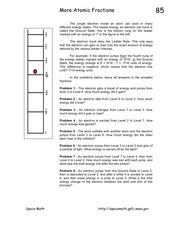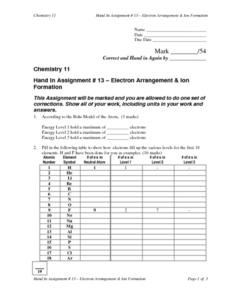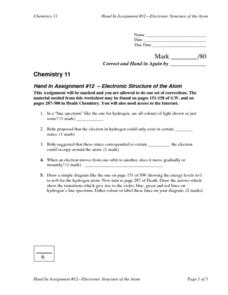Curated OER
An Electron's Address
Where does an electron reside? Chemistry scholars determine an electron's "address," that is, what orbital it can be found in. This resource is both instructional and practical, providing a thorough explanation of energy levels and...
Curated OER
Atomic Emission Spectra and the Bohr Model of the Atom
High schoolers investigate the wavelengths of spectra lines for common atoms. For this atomic emission spectra lesson plan, students use a transformer and diffraction grating to observe the emission spectra of various atoms. They find...
Curated OER
Flame Tests
Learners perform flame tests on 12 elements. In this flame tests lesson plan, students experiment with elements to observe their visible light spectra emitted as electrons jump from one energy level to another. Learners record their...
Curated OER
Periodic Table
Explanations of shell structure in an atom and the decisions that affect periodic table organization are discussed here. Students view well organized charts to list and compare elements that are placed in different sections of the...
Curated OER
More Atomic Fractions
In this atomic fractions worksheet, students use the atomic ladder rule to solve 8 problems where they determine the energy gained or lost in each atom as electrons jump from one energy level to another.
Curated OER
Atomic Fractions-III
In this atomic fractions worksheet, students read about electrons and energy levels. Students find all the possible energies that an electron could lose as it jumped from one energy level to another based on a given diagram. They...
Curated OER
Why are Electrons Important?
Students write electron configuration of elements using atomic numbers and they identify valence electrons. In this electrons lesson plan, students observe a demonstration showing the space-filling property of an electron. They also...
Curated OER
The Atoms Family Album
In the atom worksheet, students read a story about the "Atoms Family" and are given descriptions of the structures of atoms through the story. Students interpret the descriptions by drawing the described atom structure, they name of the...
Curated OER
The Periodic Table
In this periodic table worksheet, students answer 10 questions about the periodic table, the elements in the periodic table, the properties of elements and the atomic number, symbol and name of elements in groups of the periodic table.
Curated OER
What Information is on the Periodic Table?
In this elements worksheet, students review the information that is found on a periodic table including atomic mass, chemical symbol, atomic, number, and electron configuration. This worksheet has 7 fill in the blank questions.
Curated OER
Integrating Physics-Atomic Fingerprints
In this atomic fingerprint instructional activity, students read about the Bohr model and electrons changing energy levels and emitting energy. They answer questions about the atomic spectrum and the fingerprints for specific atoms.
Curated OER
Configure Your Electron Notes
In this electron configuration worksheet, students fill in a table with the number of electrons, the number of orbitals, the type of orbitals and the total number of electrons per orbital in each principle energy level. They then write...
Curated OER
Bohr Energy Level Diagrams for Atoms
For this Bohr model worksheet, students draw 16 diagrams given atoms in the periodic table and must show the energy level diagrams indicating the electrons in each energy level.
Curated OER
Bohr Energy Level Diagrams for Ions
In this Bohr model learning exercise, students draw Bohr energy level diagrams for 14 ions. They draw the electrons in the outer orbitals and indicate the charges on the ions.
Curated OER
Where are the Electrons?
In this electrons worksheet, students complete a graphic organizer to show the pattern of the principal energy levels, number of orbitals, and electrons in each sublevel of atoms.
Curated OER
Electron Arrangement and Ion Formation
In this elements worksheet, learners determine how electrons fill up the energy levels for the first 18 elements of the periodic table. Students determine if elements gain or lose electrons to form a stable ion. This worksheet has 4...
Curated OER
Electron Structure of the Atom
In this atoms worksheet, students determine the energy difference between levels and draw diagrams of the different types of orbitals. Students determine the ground state electron configuration for given elements. This worksheet has 14...
Curated OER
Electromagnetic Radiation and the Bohr Atom
In this light worksheet, students calculate the frequency and wavelength. Students practice applying Planck's constant and determining the energy of a photon. This worksheet has 9 problems to solve.
Curated OER
The Story of the Atom
In this atom instructional activity, students read about the model of the atom developed by Neils Bohr. Students complete 2 short answer questions based on what they read.
Curated OER
Boron and Oxygen Atoms
For this atom molecule worksheet, students will use a boron atom diagram to answer three fill-in-the-blank questions. Then students will label the protons, neutrons, and electrons on an oxygen atom diagram.
Curated OER
Sleuth Rays
Students conduct a close examination of the atom's electrons, and discover how to theorize the energy levels, observe the brightness of light, classify colors, and measure temperature.






















